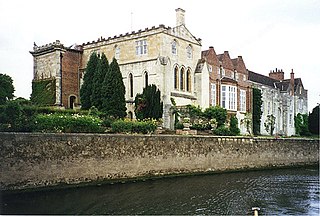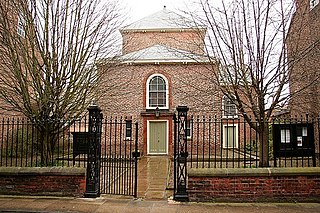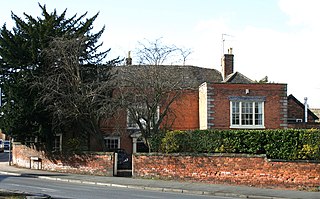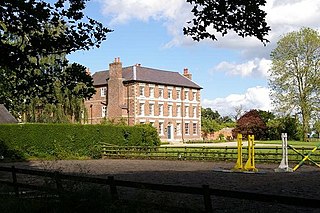
Bishopthorpe Palace is a historic house at Bishopthorpe, to the south of York, in the City of York unitary authority and ceremonial county of North Yorkshire, England. It is situated on the River Ouse and is the official residence of the Archbishop of York. In the local area it is known as "the Archbishop's Palace".

Parkgate railway station was a station on the single track Hooton to West Kirby branch of the Birkenhead Railway, on the Wirral Peninsula, Cheshire, England. The station served the village of Parkgate.

York Unitarian Chapel is a building on St. Saviourgate, York, England. It is a member of the General Assembly of Unitarian and Free Christian Churches, the umbrella organisation for British Unitarians.

83 Welsh Row is a Georgian town house in Nantwich, Cheshire, England, dating from the late 18th century, located on the south side of Welsh Row. It is currently used as offices. It is listed at grade II*; in the listing, English Heritage describes it as "a good tall late C18 house", featuring a "good doorway".

Townwell House is an Early Georgian town house in Nantwich, Cheshire, England, located at number 52 on the north side of Welsh Row. It dates from 1740, and is listed at grade II*; in the listing, English Heritage describes the building as "important" and highlights its "good central entrance".

The Rookery, or 125 Hospital Street, is a substantial Georgian townhouse in Nantwich, Cheshire, England. It is at the end of Hospital Street, on the north side, at the junction with Millstone Lane. The existing building dates from the mid-18th century and is listed at grade II; English Heritage describes it as "good" in the listing. Nikolaus Pevsner describes it as "square and stately." It incorporates an earlier timber-framed house at the rear, which probably dates from the late 16th or early 17th century.

The Gateway, or 60–62 Welsh Row, is a Late Georgian former stable entrance in Nantwich, Cheshire, England, dating from the early 19th century. It is located on the north side of Welsh Row, on the junction with Red Lion Lane. It is listed at grade II. Nikolaus Pevsner describes The Gateway as "handsome".

Newland is a suburb of Kingston upon Hull, East Riding of Yorkshire, England, in the north-west of the city, a former village on the Hull to Beverley turnpike.

Asia House at No. 82 Princess Street, Manchester, England, is an early 20th century packing and shipping warehouse built between 1906 and 1909 in an Edwardian Baroque style. It is a Grade II* listed building as at 3 October 1974. Nikolaus Pevsner's The Buildings of England describes the warehouse, and its companion, No. 86, Manchester House, as "quite splendid ... good examples of the warehouse type designed for multiple occupation by shipping merchants". It attributes its design to I.R.E. Birkett, architect of the Grade II listed companion building, Manchester House, which is similar in design. English Heritage attributes it to Harry S. Fairhurst. Asia House has an "exceptionally rich" entrance hall and stairwell, "lined with veined marble and green and cream faience, with designs of trees and Art Nouveau stained glass".

Baddiley Hall is a country house in the settlement of Baddiley in Cheshire, England. Previously there was a half-timbered house on the site, but this had been replaced by the current house before the death of its owner, Sir Henry Mainwaring, in 1797. It is constructed in brown brick with a tiled roof, and has an L-shaped plan. Its architectural style is Georgian. The house is recorded in the National Heritage List for England as a designated Grade II listed building. Figueirdo and Treuherz comment that it is "a modest Georgian brick manor house, hardly more than a farmhouse".

Bostock Hall is a country house to the northeast of Winsford, Cheshire, England. A former Georgian house, it was rebuilt in 1775 for Edward Tomkinson. It is thought that the architect was Samuel Wyatt. Alterations and additions were made to it in the middle of the 19th century and in 1875. The house is constructed in brick with ashlar dressings; it has a slate roof. It is in three storeys plus a basement. Its plan is L-shaped. The entrance front has a central bow window rising through all floors, and a single-storey porch with a balustraded parapet. The garden front has two bows, between which are a Venetian window with a Diocletian window above. The house is recorded in the National Heritage List for England as a designated Grade II* listed building.

Bulkeley Hall is a country house to the southwest of the village of Bulkeley, Cheshire, England. It dates from the middle of the 18th century, and was built for Thomas Bulkeley. The house is constructed in brick with a slate roof. Its architectural style is Georgian. The entrance front has three storeys, and is in seven bays. A service wing at right-angles gives it an L-shaped plan. The interior contains 18th-century plasterwork and joinery. The house is recorded in the National Heritage List for England as a designated Grade II* listed building.
Legh Hall stands to the east of the village of Mottram St Andrew, Cheshire, England. It was built in the middle of the 18th century for William Brocklehurst of Macclesfield. The house was built to replace Legh Old Hall. Additions were made in the late 19th century, with alterations in the 20th century. The house is constructed in red brick with yellow headers. It is roofed with Welsh slate. Its architectural style is Georgian. The house is in 2½ storeys, and has a symmetrical five-bay front. It is recorded in the National Heritage List for England as a designated Grade II listed building.
Oughtrington Hall was a country house located in Oughtrington Lane to the east of the village of Lymm in Cheshire, England.
The former Governor's House is located in Toft Road, Knutsford, Cheshire, England. It was built for the governor of Knutsford Gaol, and has later been used as a Tourist Information Centre. It was built in 1844 and designed by the Lancaster architect Edmund Sharpe. It is recorded in the National Heritage List for England as a designated Grade II listed building. The house is constructed in red brick in Georgian style. It served as the central offices for the Knutsford Urban District Council, and then for Knutsford Town Council which have been located there since the council formed in 1974.

Fairfax House is a Georgian townhouse located at No. 27, Castlegate, York, England, near Clifford's Tower and York Castle Museum. It was probably built in the early 1740s for a local merchant and in 1759 it was purchased by Charles Gregory Fairfax, 9th Viscount Fairfax of Emley, who arranged for the interior to be remodelled by John Carr (architect). Fairfax was the widower of heiress Elizabeth Clifford, daughter of Hugh Clifford, 2nd Baron Clifford of Chudleigh: his inheritance from her death enabled him to purchase the house, which he intended as a home for his daughter from his first marriage, Ann Fairfax.

Castlegate House is a Georgian Grade I listed building in central York, in England.

Bedern is a street in the city centre of York, in England, which originated as a college for the vicars choral of York Minster.

Dorothy Wilson's Hospital is a historic almshouse in the city centre of York, in England.

















